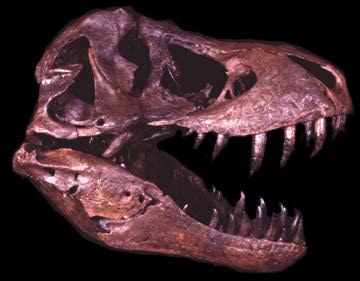

Actual skull of STAN, now considered to be the second most complete T. rex ever found.
REPORT FROM REXBERG
THE TYRANNOSAURUS REX
CAPITAL OF THE WORLD
by Paul R. Janke
Amateur fossil hunter Steve Sacrison was on a fossil walkabout in
searing 100+ degree heat when he noticed a small patch of ground
that seemed to reflect the afternoon sunlight in a slightly
unusual way. He kneeled down for a closer look and found a few
loose chunks of weathering bone next to the small patch. A quick
look at the structure in one of the larger bone chunks and he
immediately knew it was T. rex. Pete Larson of the Black
Hills Institute of Geological Research (BHIGR) soon confirmed his
discovery. The small patch that caught Steve's eye turned out to
be the bone surface of a nearly complete femur, still mostly
buried in the siltstone, mudstone and ironstone of the Hell Creek
Formation.
Finding T. rex fossils used to be a rare event. Thanks
to the efforts of some dedicated amateurs, they're now being
found all over the place. Especially if the place is near Harding
County, South Dakota. The area around the town of Buffalo has
produced so many (6 new specimens in the last 8 years) that it
has become the T. rex capital of the world. Researchers
are using these new finds to re-write the book on T. rex
as each new site and every new bone adds to our growing knowledge
of this most famous dinosaur.
The high number of recent discoveries near Buffalo can be
attributed in part to the excellent exposures of the Hell Creek
Formation in the surrounding badlands. However, what really sets
this area apart from similar Hell Creek localities is the superb
job done by amateurs in locating new sites. Twin brothers Stan
and Steve Sacrison are persistent, experienced fossil hunters.
They have already found 3 major T. rex specimens near
their home town of Buffalo. It's a testimony to amateur
dedication when two brothers from South Dakota account for around
15% of the entire known inventory of T. rex bone. Stan
Sacrison is the discoverer of Stan and Duffy, while brother Steve
found his namesake Steven.
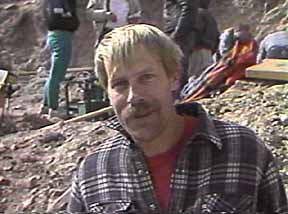
Amateur fossil hunter Stan Sacrison, the discoverer of 2 T.rex! (STAN and Duffy)
I had the opportunity to do some fieldwork and digging at these
sites in August, 1995, right after Steven was discovered. Our
camp area is affectionately referred to as "Rexberg".
The sites for Stan, Duffy, and Steven are all within a mile of
camp. These digsites are managed by scientists from the BHIGR who
run a paleo lab and non-profit natural history museum in Hill
City, SD. The game plan was to begin documenting and then digging
at the Steven site and also do some follow-up work at the Stan
and Duffy sites.
The fieldwork on Steven began with a meticulous surface
examination. We spent several days bagging and labelling every
piece of bone on the surface. We took lots of pictures and
videos, screened for small fossil fragments and explored downhill
for pieces of bone that may have washed down from the site.
Excitement almost reached a fever pitch when fossil eggshell
fragments were spotted by Leon "the eggman goo goo goo
joob" Theisen. Based on their curvature, these fragments
came from an original egg measuring around 20 x 8 inches. They
display a telltale knobby texture with pores and were found in
direct association with the main group of Steven bones. Bob
Farrar of the BHIGR described these fragments as "definitely
matching Chinese theropod eggshell". They most likely
represent the first T. rex egg fossils ever found in the
Hell Creek Fm. We started to speculate about possible T. rex
nesting grounds and considered the option of changing the
specimen name from Steven to Stevie!
Along with the surface analysis, a grid was set up so the bones
could be mapped in context as we began to dig. In the week I was
on site we uncovered several ribs and vertebrae along with the
femur. The bones seem to continue under a small hill, which won't
be opened up until next field season. There are two things you
learn about the T. rex fossils of Harding County: 1)
they're all over the place, and 2) when you find one, it's all
over the place. Often the remains cover a wide area surrounding
the main group of bones. It will be a while before we know just
how much of Steven's skeleton has been preserved.
My first visit to the Stan site turned up a nice surprise as
well. Spring rains had neatly uncovered a gastralia (almost
certainly from Stan) which Neal Larson of the BHIGR instantly
recognized. This is one of the reasons that you have to keep
visiting sites periodically. The forces of weathering are steady
and unforgiving. Freeze/thaw cycles, wind, plant roots and
especially "gully-washer" rainstorms constantly attack
fossil treasures and turn them into dust. Thanks to the
innovative field techniques of the BHIGR and assistance of
amateurs, Stan is now considered to be the second most complete T.
rex ever found.
Work on the Duffy site may have been the most interesting of all.
Several days of digging saw the discovery of 4 new whole teeth,
complete with roots, along with quite a bit of well preserved
skull material. These finds were made more than 50 feet away from
the main bone concentration, outside the radius that scientists
usually explore. It really got me wondering about the other T.
rex specimens found earlier this century. I'd be willing to
wager that a lot more skeletal material could be found at those
sites if they had the same amateur involvement and used the same
field techniques as the BHIGR scientists.
The T. rex of Harding County were some of the last
dinosaurs to walk the earth. The Cretaceous/Tertiary(K/T)
boundary defines the end of the age of dinosaurs. This boundary
is evident near the tops of many of the taller buttes in the
Buffalo area, where bright white Paleocene sediments overlay a
dark black layer of Cretaceous coal. The actual boundary is near
the middle of the coal layer at the Rexberg locality. Although no
distinctive boundary clay is present here, the abrupt pollen
changes and iridium/siderophile anomalies characteristic of K/T
sections worldwide have been documented. The boundary is a just a
short climb (less than 100 feet) up from the Stan and Duffy
sites, while Steven appears to rest even closer to the boundary.
These three animals do not appear to have been contemporaries
back in the Cretaceous. Stratigraphy indicates they were
separated in time by perhaps a few thousand years.
I would like to give special thanks to Pete and Neal Larson, Bob
Farrar and Terry Wentz of the BHIGR for sharing their expertise
and knowledge with me both in the field and back at the lab.
Their mounted T. rex specimens along with their famous
collection of beautiful fossils are on display at the Black Hills
Museum of Natural History in Hill City, SD. This team of dinosaur
experts is lifting T. rex science to new heights. The
specimens found, excavated and prepared by the BHIGR are widely
renowned for what they have revealed about behavior, pathology,
taphonomy, anatomy, sexual dimorphism and even possible
cannibalism! Future reports from Rexberg will examine Stan, Duffy
and Steven in more detail to see how in spite of their
similarities, each individual has its own story to tell.
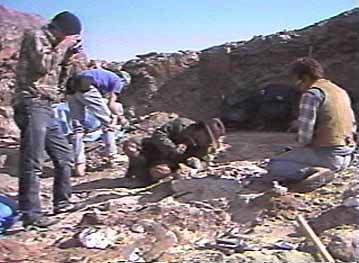
Pete and Neal Larson working at the STAN site.
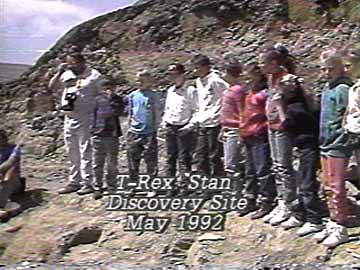
Sites managed by the Black Hills Institute receive hundreds of visitors.
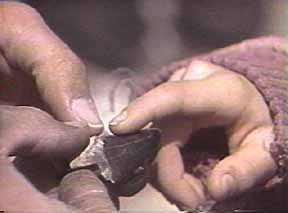
A young student discovers the serrations on a T. rex tooth.
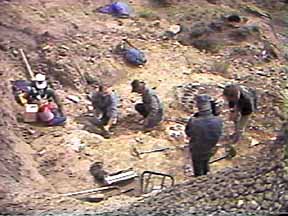
Overview of the STAN site.
Copyright 1999 by Pan Terra Inc., PO Box 556, Hill City, SD, USA 57745.
All rights reserved.......Tel or fax 605-574-4760